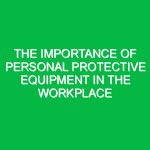Personal Protective Equipment (PPE) plays a crucial role in ensuring the health and safety of workers in various industries. From construction sites to healthcare facilities, PPE is essential for protecting employees from potential hazards and preventing workplace injuries. In this article, we will explore the importance of PPE in the workplace and why it should be a top priority for employers and employees alike.
What is Personal Protective Equipment?
Personal Protective Equipment, commonly referred to as PPE, includes items such as gloves, helmets, goggles, face shields, masks, respirators, safety shoes, and protective clothing. These items are designed to protect workers from physical, chemical, biological, and other hazards that may be present in the workplace.
The Role of PPE in Ensuring Workplace Safety
PPE serves as the last line of defense against workplace hazards. While engineering controls and administrative measures are crucial for hazard prevention, PPE provides an additional layer of protection for workers. By wearing the appropriate PPE, employees can reduce their risk of injury or illness while performing their job duties.
Types of Personal Protective Equipment
There are various types of PPE available, each designed to protect against specific hazards. For example, safety goggles are essential for protecting the eyes from chemical splashes or flying debris, while respirators are necessary for filtering out harmful airborne particles. Employers must assess the workplace hazards and provide the appropriate PPE to ensure the safety of their employees.
Ensuring Proper Fit and Use of PPE
It is not enough to simply provide PPE to employees; it is equally important to ensure that the equipment fits properly and is used correctly. Ill-fitting PPE can compromise its effectiveness and put workers at risk. Employers should provide training on how to properly wear and maintain PPE to maximize its protective capabilities.
Additionally, regular inspections and maintenance of PPE are essential to ensure that the equipment remains in good condition and continues to provide adequate protection. Employees should also be encouraged to report any issues or concerns regarding their PPE so that corrective actions can be taken promptly.
The Benefits of Using Personal Protective Equipment
There are numerous benefits to using PPE in the workplace. By wearing the appropriate protective gear, employees can reduce their risk of injury, illness, or even death. PPE also helps to create a safe work environment, boosting employee morale and productivity.
Furthermore, using PPE can help employers comply with occupational health and safety regulations, avoiding costly fines and penalties. By investing in the safety and well-being of their employees, employers can build a positive reputation and attract top talent to their organization.
Conclusion
In conclusion, Personal Protective Equipment is a vital component of workplace safety. Employers must prioritize the provision of appropriate PPE and ensure that employees are trained on its proper use. By investing in PPE, employers can protect their workforce, prevent workplace injuries, and create a culture of safety within their organization.


